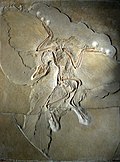Opisthotonic death pose
Opisthotonic Death Pose is a term used in paleontology and archaeology to describe a common position found in the fossilized remains of some dinosaurs and other vertebrates. The pose is characterized by the head thrown back, the tail extended, and the limbs contracted, giving the appearance of a severe arching of the back. This posture has been a subject of interest and debate among scientists, as it provides insights into the circumstances surrounding the death and fossilization of these ancient creatures.
Causes[edit]
The opisthotonic death pose is believed to be caused by several factors, primarily related to the agonizing conditions experienced by the animal at the time of death. One leading theory suggests that it is a result of tetanus or other neurological disorders that lead to muscle spasms and stiffness. Another theory proposes that the pose is a post-mortem condition, where the drying and contracting of muscles and ligaments during decomposition pulls the body into this characteristic arch. Additionally, environmental factors such as water currents for aquatic or semi-aquatic creatures could also contribute to the positioning of the body in such a manner during the process of fossilization.
Significance in Paleontology[edit]
Understanding the opisthotonic death pose is crucial for paleontologists as it aids in reconstructing the events leading up to, and following, the death of the organism. It provides valuable information on the environment where the organism died and how its body was affected by post-mortem processes. This, in turn, helps in the accurate interpretation of the fossil record and in making inferences about the behavior, ecology, and physiology of extinct species.
Controversies and Challenges[edit]
The interpretation of the opisthotonic death pose has been a subject of controversy within the scientific community. Some researchers argue that the pose is not a reliable indicator of the death throes of the animal but rather a result of the fossilization process and the conditions of burial. This debate highlights the challenges in paleontological research, where scientists must often make inferences based on incomplete data and the complex processes of fossilization that can alter the appearance of fossil remains.
Examples[edit]
Famous examples of fossils found in the opisthotonic death pose include many species of dinosaurs, such as Archaeopteryx, and early birds. These specimens have provided invaluable insights into the evolution of birds from theropod dinosaurs and the biomechanics of ancient avian species.
Conclusion[edit]
The opisthotonic death pose remains an important phenomenon for understanding the final moments of ancient creatures and the conditions of their fossilization. Despite the challenges and controversies in interpreting this pose, it continues to be a significant area of study in paleontology, offering glimpses into the past and helping to unravel the mysteries of ancient life on Earth.

This article is a paleontology stub. You can help WikiMD by expanding it!
-
Opisthotonic death pose
-
Opisthotonic death pose
-
Opisthotonic death pose
-
Opisthotonic death pose
-
Opisthotonic death pose
-
Opisthotonic death pose
-
Opisthotonic death pose
-
Opisthotonic death pose
-
Opisthotonic death pose
Ad. Transform your life with W8MD's Budget GLP-1 injections from $75


W8MD offers a medical weight loss program to lose weight in Philadelphia. Our physician-supervised medical weight loss provides:
- Weight loss injections in NYC (generic and brand names):
- Zepbound / Mounjaro, Wegovy / Ozempic, Saxenda
- Most insurances accepted or discounted self-pay rates. We will obtain insurance prior authorizations if needed.
- Generic GLP1 weight loss injections from $75 for the starting dose.
- Also offer prescription weight loss medications including Phentermine, Qsymia, Diethylpropion, Contrave etc.
NYC weight loss doctor appointmentsNYC weight loss doctor appointments
Start your NYC weight loss journey today at our NYC medical weight loss and Philadelphia medical weight loss clinics.
- Call 718-946-5500 to lose weight in NYC or for medical weight loss in Philadelphia 215-676-2334.
- Tags:NYC medical weight loss, Philadelphia lose weight Zepbound NYC, Budget GLP1 weight loss injections, Wegovy Philadelphia, Wegovy NYC, Philadelphia medical weight loss, Brookly weight loss and Wegovy NYC
|
WikiMD's Wellness Encyclopedia |
| Let Food Be Thy Medicine Medicine Thy Food - Hippocrates |
Medical Disclaimer: WikiMD is not a substitute for professional medical advice. The information on WikiMD is provided as an information resource only, may be incorrect, outdated or misleading, and is not to be used or relied on for any diagnostic or treatment purposes. Please consult your health care provider before making any healthcare decisions or for guidance about a specific medical condition. WikiMD expressly disclaims responsibility, and shall have no liability, for any damages, loss, injury, or liability whatsoever suffered as a result of your reliance on the information contained in this site. By visiting this site you agree to the foregoing terms and conditions, which may from time to time be changed or supplemented by WikiMD. If you do not agree to the foregoing terms and conditions, you should not enter or use this site. See full disclaimer.
Credits:Most images are courtesy of Wikimedia commons, and templates, categories Wikipedia, licensed under CC BY SA or similar.
Translate this page: - East Asian
中文,
日本,
한국어,
South Asian
हिन्दी,
தமிழ்,
తెలుగు,
Urdu,
ಕನ್ನಡ,
Southeast Asian
Indonesian,
Vietnamese,
Thai,
မြန်မာဘာသာ,
বাংলা
European
español,
Deutsch,
français,
Greek,
português do Brasil,
polski,
română,
русский,
Nederlands,
norsk,
svenska,
suomi,
Italian
Middle Eastern & African
عربى,
Turkish,
Persian,
Hebrew,
Afrikaans,
isiZulu,
Kiswahili,
Other
Bulgarian,
Hungarian,
Czech,
Swedish,
മലയാളം,
मराठी,
ਪੰਜਾਬੀ,
ગુજરાતી,
Portuguese,
Ukrainian








